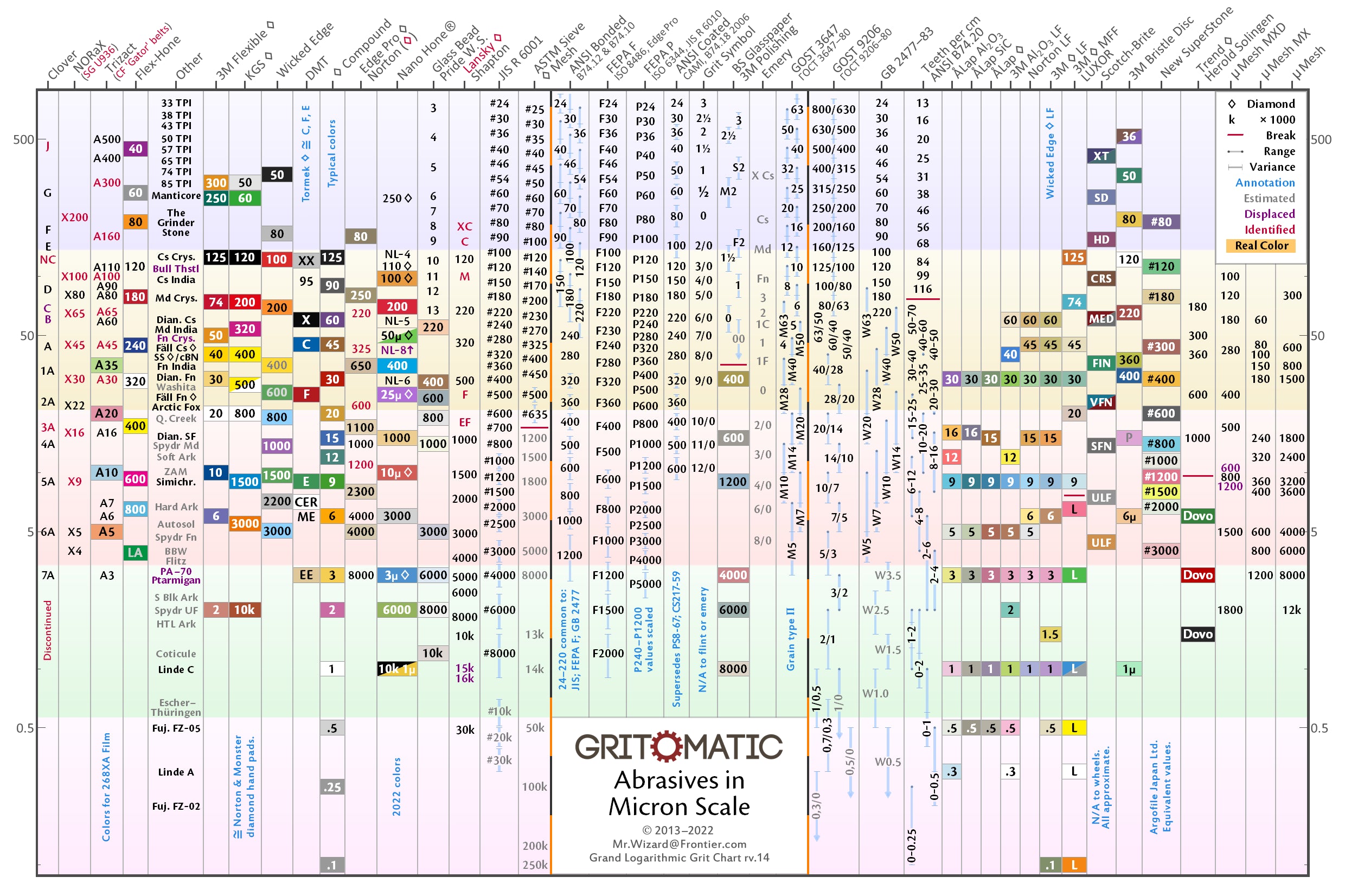Grit Size Evaluation Methods
Introduction
Accurately identifying the abrasive grit size of sharpening stones is critical for quality control, performance prediction, and material matching. While tactile assessment is often used informally, it lacks precision and reproducibility. This article compares multiple evaluation methods—ranging from subjective techniques to advanced analytical tools—highlighting their strengths, weaknesses, and best-use scenarios. It provides practical guidance on how to choose and apply each method depending on context, available resources, and required precision.
- Tactile comparison — fast but imprecise
- Profilometry — evaluates output, not particles
- Microscopy / SEM / XRD — deep structural/compositional insights
- Reference stones — empirical baseline for experienced users
Tactile Comparison
💡 The method of subjectively comparing abrasive grit sizes based on the tactile smoothness of stone surfaces—without using objective measurement tools—is unacceptable as a scientific or engineering method when the goal is to reliably identify or compare grit sizes.
Why the Method is Unacceptable
- Subjectivity of Perception. Tactile sensations depend on individual skin sensitivity, temperature, humidity, fatigue, and other personal factors. Different people perceive identical surfaces differently — the test is not reproducible.
- Variability of Working Surfaces. A sharpening stone’s surface may be contaminated, glazed, partially worn, or retain honing fluid residue — all of which affect smoothness but do not reflect actual grit size.
- Insufficient Tactile Resolution. Human touch cannot reliably distinguish microtexture details necessary for grit sizes finer than ~30 μm. Surfaces may feel equally smooth despite significant grit differences.
- Influence of Bond Type and Structure. Two stones with the same abrasive grit but different bonds (e.g., vitrified vs. resin) may feel different — not due to grit size, but due to matrix structure.
- False Equivalence of Smoothness and Grit. Even if two surfaces feel “equally smooth,” the grit sizes may differ. Smoothness depends not only on grain size but also on grain distribution and fracture behavior.
Limited Acceptability — in Specific Cases
- Preliminary Sorting - For rough classification (e.g., separating coarse from fine stones before lab testing); as a quick field method when no instruments are available.
- Sensory Training - For educational demonstrations to help beginners develop a feel for texture — but only when the grit sizes are already known.
🎯 If the goal is to identify or compare abrasive grit sizes accurately, objective methods should be used.
Assessment of the Resulting Surface: Profilometry (Ra/Rz)
💡 This method does not measure the stone’s grit size directly, but allows you to estimate it based on the surface it produces on a workpiece.
When the Method Is Applicable and Useful
- Evaluating the Stone's Functional Effect - Measures Ra, Rz, Rsk, Rku. Dependent on grit size, shape, pressure, angle, bonding type.
- Building an Empirical Reference Scale - Reference tables (FEPA/JIS ↔ Ra values) allow approximate grit evaluation.
- Analyzing Stones After Break-In or Restoration - Shows aggressiveness loss, clogging, performance after cleaning.
- Ideal for Quality Control - Provides quantitative, repeatable data.
Limitations and Caveats
- The Method Does Not Measure the Stone's Surface
- Strong Dependence on Working Conditions
- Limitations with Ultra-Fine Abrasives
- Cannot Identify Composition or Bonding Type
Optical Microscopy & Microphotography of Abrasive Surface
💡 Can determine grit size with high reliability if standards and procedures are used.
When This Method Is Valid for Grit Size Estimation
- Visible, Exposed Grain Structure
- High-Resolution Imaging Tools Available
- Known Correlation with Manufacturer Specs
Limitations of the Method
- Not All Grains Are Visible
- Grain Size ≠ Surface Roughness
- Difficulty Distinguishing Fine Grains
- Subjective Interpretation
Recommended Usage
- Use for comparative analysis
- Combine with reference samples
- Use image analysis software
🎯 Microscopy is valid and powerful, but should be used with other methods for precision.
Advanced Destructive Methods: XRD and SEM-EDS
💡 Offer insight into composition and structure, not direct grit measurement.
Applications
- SEM: morphology, wear patterns, distribution
- EDS: elemental analysis
- XRD: crystalline phases, bond content
- Used in: R&D, failure analysis, authentication
Limitations and Challenges
- No direct grit size output
- Destructive sampling
- High cost and complexity
- Grain exposure may be incomplete
Best as complementary tools—not primary grit measurement methods.
Reference Comparison
💡 Practical, fast, empirical—when instruments are unavailable.
When Useful
- Side-by-side feel or scratch comparison with known stones
- Field validation, mislabel detection
- Non-destructive, useful in experienced hands
Limitations
- Subjective, skill-based
- Not quantifiable
- Affected by bonding and wear
Grit Size Evaluation Methods
| Method | Direct Grit Measurement | Destructive | Objective | Best Used For | Limitations |
|---|---|---|---|---|---|
| Tactile Comparison | ❌ No | ❌ No | ❌ No | Quick checks, field sorting, training | Subjective, not reproducible |
| Profilometry (Ra/Rz) | ❌ No | ❌ No | ✅ Yes | Output testing, QC | Strongly depends on working conditions |
| Optical Microscopy | ✅ If grains visible | ❌ No | ⚠️ Partial | Comparison, reverse engineering | Grain exposure, user interpretation |
| SEM / EDS / XRD | ⚠️ Indirect (via SEM) | ✅ Yes | ✅ Yes | R&D, forensic, material ID | Destructive, expensive |
| Reference Comparison | ⚠️ Approximate | ❌ No | ⚠️ Partial | Field use, training | Subjective, bonding/surface dependent |




